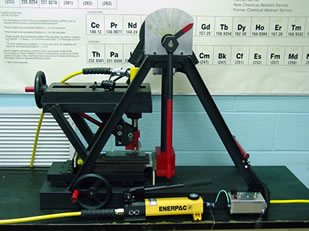ABL Friction Test Apparatus
Energetic Materials Business Unit
 |
| ABL Friction Test Apparatus |
The ABL friction test uses a line of explosives on a prepared metal plate, placed in front of a specially prepared metal wheel that is forced down upon the plate with a hydraulic press. The metal plate is then struck with a pendulum to move it, squeezing the explosives between plate and wheel as the plate moves. Initiation is determined, and analyzed by the Bruceton analysis or Neyer d-optimal test.
UTEC provides the ABL Friction Apparatus for clients who require in-house testing to determine the energy required to initiate a sample by friction energy application.
The primary parts of the test apparatus are a moving anvil upon which the test sample is placed, a stationary wheel that applies a load to the sample, and a swinging pendulum that strikes the anvil to move it under the stationary wheel.
An explosive sample is placed on the anvil and the stationary wheel is lowered onto the sample such that the sample is pinched between the wheel and the anvil. The wheel is then statically loaded by a hydraulic ram to a predetermined load. The pendulum is positioned and released at an angle that will impart a predetermined velocity to the sliding anvil. A travel distance of approximately one inch perpendicular to the applied force is achieved with this apparatus. Initiation of the sample is determined by production of smoke, fire or an audible pop. Gas detection by infrared sampling analysis is also possible.
This test simulates potential initiation of explosive that may be caught in mechanical parts, which could apply a pinch or sliding load on the explosive. Solids, liquids, or powders can be tested with this apparatus.
Want to learn more? Download the ABL Friction Test Apparatus brochure and contact us today.

